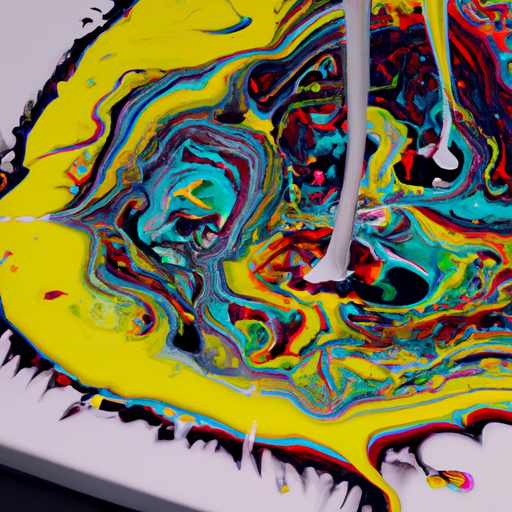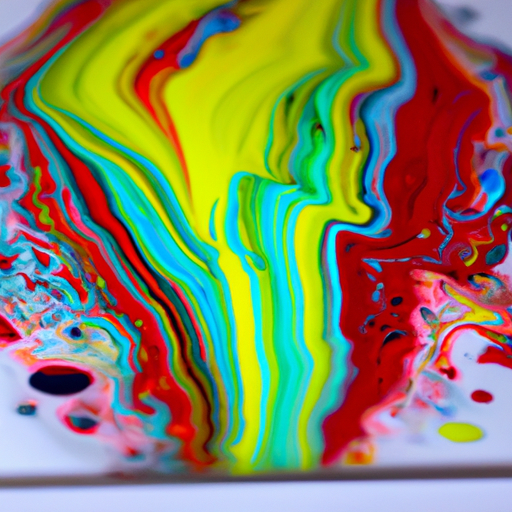
-
Table of Contents
- Acrylic Pouring and Its Use in Abstract Graphic Design
- What is Acrylic Pouring?
- The Process of Acrylic Pouring
- Acrylic Pouring in Abstract Graphic Design
- Case Studies: Acrylic Pouring in Abstract Graphic Design
- Case Study 1: “Ocean Waves”
- Case Study 2: “Cityscape”
- The Growing Popularity of Acrylic Pouring
- Conclusion
Acrylic Pouring and Its Use in Abstract Graphic Design

Abstract graphic design is a dynamic and expressive form of art that allows artists to explore their creativity and push the boundaries of traditional design. One technique that has gained popularity in recent years is acrylic pouring. Acrylic pouring involves pouring layers of acrylic paint onto a canvas or other surface to create unique and mesmerizing patterns. In this article, we will explore the art of acrylic pouring and its use in abstract graphic design.
What is Acrylic Pouring?
Acrylic pouring, also known as fluid art or liquid art, is a technique that involves mixing acrylic paint with a pouring medium and then pouring it onto a canvas or other surface. The pouring medium helps to create a smooth and flowing consistency, allowing the paint to move and blend together in fascinating ways. The artist can manipulate the paint by tilting the canvas or using various tools to create different effects.
One of the reasons why acrylic pouring has become so popular is its unpredictability. Each pour is unique, and the artist has limited control over the final outcome. This element of surprise adds excitement and intrigue to the process, making it a favorite among artists and art enthusiasts.
The Process of Acrylic Pouring
The process of acrylic pouring involves several steps:
- Prepare your workspace: Acrylic pouring can get messy, so it’s important to protect your work area with plastic sheets or drop cloths. Gather all the necessary materials, including acrylic paint, pouring medium, mixing cups, stir sticks, and a canvas or other surface.
- Mix your paint: In separate cups, mix your acrylic paint with the pouring medium. The ratio of paint to pouring medium may vary depending on the desired consistency and the brand of paint you are using. Experimentation is key to finding the right balance.
- Layer your paint: Pour each color of paint onto the canvas in a random or deliberate pattern. You can pour the paint directly from the cup or use various pouring techniques, such as the flip cup method or the dirty pour method.
- Manipulate the paint: Tilt the canvas in different directions to allow the paint to flow and blend together. You can also use tools like palette knives or blow dryers to create additional effects.
- Let it dry: Once you are satisfied with the design, let the painting dry completely. This may take several hours or even days, depending on the thickness of the paint and the environmental conditions.
Acrylic Pouring in Abstract Graphic Design
Acrylic pouring has found its place in the world of abstract graphic design due to its versatility and ability to create visually stunning compositions. The fluid nature of the paint allows artists to experiment with different color combinations, textures, and patterns, resulting in unique and captivating designs.
One of the key advantages of acrylic pouring in abstract graphic design is the ability to create complex and intricate patterns effortlessly. The pouring technique naturally creates organic shapes and forms that are difficult to replicate using traditional painting methods. This makes acrylic pouring an ideal choice for artists looking to add depth and complexity to their designs.
Furthermore, acrylic pouring allows artists to explore the interplay between colors and how they interact with one another. The pouring process often leads to unexpected color combinations and blending effects, creating a sense of harmony and balance in the artwork. This element of surprise adds an extra layer of excitement to the design process and keeps the viewer engaged.
Case Studies: Acrylic Pouring in Abstract Graphic Design
Let’s take a look at a few case studies that highlight the use of acrylic pouring in abstract graphic design:
Case Study 1: “Ocean Waves”
Artist Jane Smith used acrylic pouring to create a stunning abstract graphic design titled “Ocean Waves.” By layering different shades of blue and white paint, she was able to capture the movement and energy of crashing waves. The fluidity of the acrylic pouring technique added a sense of dynamism to the artwork, making it come alive on the canvas.
Case Study 2: “Cityscape”
Artist John Doe used acrylic pouring to depict a cityscape in his abstract graphic design. By pouring layers of vibrant colors and manipulating the paint with palette knives, he was able to create a sense of depth and perspective. The fluid lines and shapes created by the pouring technique added a dynamic and energetic feel to the artwork, reflecting the bustling nature of a city.
The Growing Popularity of Acrylic Pouring
Acrylic pouring has gained significant popularity in recent years, with artists and art enthusiasts embracing this unique technique. The rise of social media platforms like Instagram and YouTube has played a crucial role in spreading awareness about acrylic pouring and inspiring artists to try it for themselves.
According to a survey conducted by Art Business News, 75% of artists reported that they have experimented with acrylic pouring in their artwork. This statistic highlights the growing interest and adoption of this technique within the art community.
Furthermore, acrylic pouring has also become a popular choice for art therapy programs. The fluid and intuitive nature of the technique allows individuals to express themselves freely and explore their emotions through art. Many therapists have found that acrylic pouring can be a powerful tool for self-discovery and healing.
Conclusion
Acrylic pouring is a captivating technique that has found its place in abstract graphic design. Its fluid nature, unpredictability, and ability to create visually stunning compositions make it a favorite among artists and art enthusiasts. The interplay of colors, textures, and patterns in acrylic pouring adds depth and complexity to abstract designs, allowing artists to push the boundaries of traditional graphic design. As the popularity of acrylic pouring continues to grow, we can expect to see more innovative and mesmerizing artworks created using this technique.
